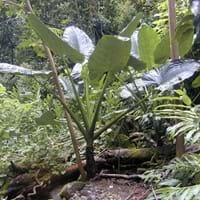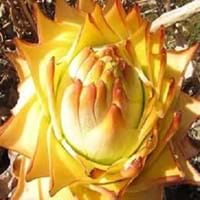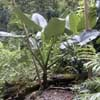Life Span
Perennial
Perennial
Type
Tender Perennial
Tender Perennial
Origin
Southeastern Asia
Southeastern Asia, India, Melanesia, Micronesia
Types
Taro Alocasia reginula, Night scented lily
not available
Habitat
Terrestrial, Wet lands
secondary forest, shaded woods
USDA Hardiness Zone
10-15
8-15
Sunset Zone
H1, H2, 22, 23, 24
H1, H2, 14, 15, 16, 17, 18, 19, 20, 21, 22, 23, 24
Habit
Cushion/Mound-forming
Clump-Forming
Flower Color
White
White, Light Pink
Flower Color Modifier
Not Available
Multi-Color
Fruit Color
Not Available
Not Available, Yellow
Leaf Color in Spring
Purple, Dark Green, Silver, Black
Yellow, Green, Dark Green, Light Yellow
Leaf Color in Summer
Purple, Dark Green, Silver, Black
Yellow, Green, Dark Green, Light Yellow
Leaf Color in Fall
Purple, Dark Green, Silver, Black
Yellow, Green, Dark Green, Light Yellow
Leaf Color in Winter
Green, Dark Green, Silver, Black
Yellow, Green, Dark Green, Light Yellow
Leaf Shape
Heart-shaped
broad, flat
Plant Season
Spring, Summer, Fall, Winter
Spring, Summer, Fall, Winter
Sunlight
Full Sun, Partial Sun, Partial shade, Full Shade
Partial Sun, Partial shade
Type of Soil
Loam
Loam, Sand
The pH of Soil
Acidic, Neutral, Alkaline
Acidic, Neutral
Soil Drainage
Well drained
Average
Bloom Time
Indeterminate
Late Spring, Early Summer, Summer
Tolerances
Full Sun, Humidity
Drought
Where to Plant?
Container, Ground, Pot
Pot
How to Plant?
Divison, From bulbs, From Rhizomes
From Rhizomes, Seedlings
Plant Maintenance
Low
Medium
Watering Requirements
Average Water Needs, Do Not over Water, Never Over-water, Water Deeply
Average Water Needs, Do not water excessively, Keep ground moist, Keep the Soil well drained
In Summer
Lots of watering
Lots of watering
In Spring
Average Water
Moderate
In Winter
Less Watering
Average Water
Soil pH
Acidic, Neutral, Alkaline
Acidic, Neutral
Soil Type
Loam
Loam, Sand
Soil Drainage Capacity
Well drained
Average
Sun Exposure
Full Sun, Partial Sun, Partial shade, Full Shade
Partial Sun, Partial shade
Pruning
Prune to stimulate growth, Remove damaged leaves, Remove dead leaves, Remove deadheads
Prune central stem, Remove damaged leaves, Remove dead branches, Remove dead leaves
Fertilizers
All-Purpose Liquid Fertilizer, Nitrogen, Phosphorous, Potassium
All-Purpose Liquid Fertilizer, slow-release fertilizers
Pests and Diseases
Blight, Mites, Red spider mite
Mealy bugs, Red spider mite
Plant Tolerance
Full Sun, Humidity
Drought
Flowers
Insignificant
Showy
Flower Petal Number
Single
Single
Fragrant Bark/Stem
No
Yes
Foliage Texture
Medium
Coarse
Foliage Sheen
Matte
Glossy
Attracts
Spider Mites
Birds, Insects, Not Available
Aesthetic Uses
Beautification, Showy Purposes
Showy Purposes, Wild gardens
Beauty Benefits
No Beauty Benefits
Not Available
Environmental Uses
Air purification, Food for insects
Air purification
Medicinal Uses
No Medicinal Use
No Medicinal Use
Part of Plant Used
Not Available
Not Available
Other Uses
Air freshner, Decoration Purposes, Showy Purposes, Used as Ornamental plant
Showy Purposes
Used As Indoor Plant
Yes
Yes
Used As Outdoor Plant
Yes
Yes
Garden Design
Bedding Plant, Container, Feature Plant, Houseplant, Mixed Border, Tropical
Container, Cutflower, Feature Plant, Foundation, Houseplant, Mixed Border, Tropical
Botanical Name
ALOCASIA reginula
ALPINIA zerumbet 'Variegata'
Common Name
Elephant Ear
Golden Lotus, Shell Ginger, Variegated Shell Ginger
In Hindi
Elephant Ear
golden lotus
In German
Elephant Ear
golden lotus
In French
Elephant Ear
golden lotus
In Spanish
Elephant Ear
golden lotus
In Greek
Elephant Ear
golden lotus
In Portuguese
Elephant Ear
golden lotus
In Polish
Elephant Ear
golden lotus
In Latin
Elephant Ear
golden lotus
Phylum
Magnoliophyta
Tracheophyta
Class
Liliopsida
Liliopsida
Order
Alismatales
Zingiberales
Family
Araceae
Zingiberaceae
Clade
Angiosperms, Monocots
Angiosperms, Commelinids, Monocots
Tribe
Colocasiodeae
Not Available
Subfamily
Aroideae
Not Available
Number of Species
Not Available
Season and Care of Elephant Ear and Golden Lotus
Season and care of Elephant Ear and Golden Lotus is important to know. While considering everything about Elephant Ear and Golden Lotus Care, growing season is an essential factor. Elephant Ear season is Spring, Summer, Fall and Winter and Golden Lotus season is Spring, Summer, Fall and Winter. The type of soil for Elephant Ear is Loam and for Golden Lotus is Loam, Sand while the PH of soil for Elephant Ear is Acidic, Neutral, Alkaline and for Golden Lotus is Acidic, Neutral.
Elephant Ear and Golden Lotus Physical Information
Elephant Ear and Golden Lotus physical information is very important for comparison. Elephant Ear height is 20.30 cm and width 30.50 cm whereas Golden Lotus height is 150.00 cm and width 120.00 cm. The color specification of Elephant Ear and Golden Lotus are as follows:
Elephant Ear flower color: White
Elephant Ear leaf color: Purple, Dark Green, Silver and Black
Golden Lotus flower color: White and Light Pink
- Golden Lotus leaf color: Yellow, Green, Dark Green and Light Yellow
Care of Elephant Ear and Golden Lotus
Care of Elephant Ear and Golden Lotus include pruning, fertilizers, watering etc. Elephant Ear pruning is done Prune to stimulate growth, Remove damaged leaves, Remove dead leaves and Remove deadheads and Golden Lotus pruning is done Prune central stem, Remove damaged leaves, Remove dead branches and Remove dead leaves. In summer Elephant Ear needs Lots of watering and in winter, it needs Less Watering. Whereas, in summer Golden Lotus needs Lots of watering and in winter, it needs Average Water.





